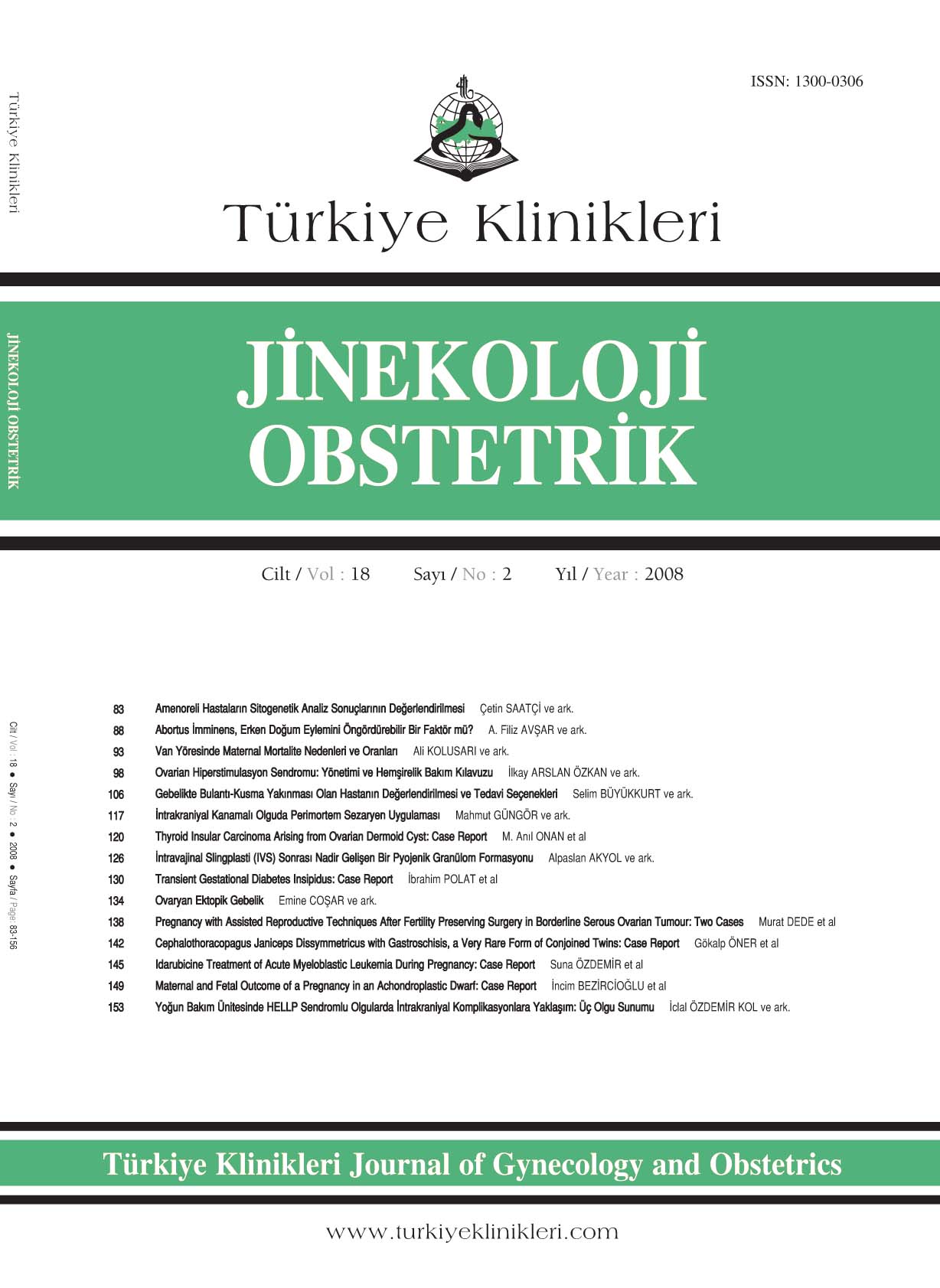Open Access
Peer Reviewed
REVIEW
4563 Viewed2190 Downloaded
Evaluation and Treatment of the Patients with Nausea and Vomiting in Pregnancy: Review
Gebelikte Bulantı-Kusma Yakınması Olan Hastanın Değerlendirilmesi ve Tedavi Seçenekleri
Turkiye Klinikleri J Gynecol Obst. 2008;18(2):106-16
Article Language: TR
Copyright Ⓒ 2020 by Türkiye Klinikleri. This is an open access article under the CC BY-NC-ND license (http://creativecommons.org/licenses/by-nc-nd/4.0/)
ÖZET
Gebelikte bulantı-kusma ilk haftalarda %50-70 sıklıkta görülür. Hiperemesis gravidarum hastalığın ağır formudur ve %1-2 sıklıkta görülür. Hastalığın etiyolojisini açıklamak için gebelikteki hormonal değişiklikler, vestibüler sistem, gastrointestinal sistem, koku duyusu, psikolojik nedenler ve genetik nedenlerle ilişkilendirilmeye çalışılmıştır. Hatta bazı yazarlar gebelikteki bulantı-kusmanın gebeyi ve fetusu gıdalar yoluyla alınacak toksinlerden korumaya yönelik bir savunma yolu olduğunu bile öne sürmektedirler. Etiyolojiyle ilgili durum bu kadar karmaşık olduğundan tedavi de semptomatik olarak yapılmaktadır. Geçmişte gebelikte bulantı-kusma tedavisi için kullanılan bir ilaç anomali yaptığı iddiasıyla mahkemede suçlanınca gebelikte ilaç kullanımıyla ilgili kaygılar da pekişmiştir. Bu nedenle bulantı-kusma yakınmasını kontrol altına almak için hipnoz, davranış tedavisi, beslenme ve yaşam alışkanlıklarının düzenlenmesi, akupunktur ve bitkisel tedaviler gibi ilaç dışı yollara eğilim artmıştır. Bu tür basit yöntemlerle kontrol altına alınamayan hastalar için ise ilaç seçenekleri gündeme gelmektedir. En eski ve en sık kullanılan ilaç klasik H1 antihistaminiklerle birlikte vitamin B6'dır. Dopamin antagonitleri, 5-HT3 blokerleri ve kortikosteroidler tedavide kullanılan diğer ilaçlardır. Bu ilaçların da nasıl etkili olduğu tam olarak bilinmemektedir. Gebelikte bulantı-kusmanın etiyolojisi hakkındaki veriler kısıtlı olduğundan daha fazla bilgi edinene kadar yukarıda anılan semptomatik tedaviler kullanılacaktır. Eldeki veriler kısıtlı olsa da, şu ana kadar bu ilaçların kullanılmasının fetal anomali riskini artırdığı gösterilememiştir.
Gebelikte bulantı-kusma ilk haftalarda %50-70 sıklıkta görülür. Hiperemesis gravidarum hastalığın ağır formudur ve %1-2 sıklıkta görülür. Hastalığın etiyolojisini açıklamak için gebelikteki hormonal değişiklikler, vestibüler sistem, gastrointestinal sistem, koku duyusu, psikolojik nedenler ve genetik nedenlerle ilişkilendirilmeye çalışılmıştır. Hatta bazı yazarlar gebelikteki bulantı-kusmanın gebeyi ve fetusu gıdalar yoluyla alınacak toksinlerden korumaya yönelik bir savunma yolu olduğunu bile öne sürmektedirler. Etiyolojiyle ilgili durum bu kadar karmaşık olduğundan tedavi de semptomatik olarak yapılmaktadır. Geçmişte gebelikte bulantı-kusma tedavisi için kullanılan bir ilaç anomali yaptığı iddiasıyla mahkemede suçlanınca gebelikte ilaç kullanımıyla ilgili kaygılar da pekişmiştir. Bu nedenle bulantı-kusma yakınmasını kontrol altına almak için hipnoz, davranış tedavisi, beslenme ve yaşam alışkanlıklarının düzenlenmesi, akupunktur ve bitkisel tedaviler gibi ilaç dışı yollara eğilim artmıştır. Bu tür basit yöntemlerle kontrol altına alınamayan hastalar için ise ilaç seçenekleri gündeme gelmektedir. En eski ve en sık kullanılan ilaç klasik H1 antihistaminiklerle birlikte vitamin B6'dır. Dopamin antagonitleri, 5-HT3 blokerleri ve kortikosteroidler tedavide kullanılan diğer ilaçlardır. Bu ilaçların da nasıl etkili olduğu tam olarak bilinmemektedir. Gebelikte bulantı-kusmanın etiyolojisi hakkındaki veriler kısıtlı olduğundan daha fazla bilgi edinene kadar yukarıda anılan semptomatik tedaviler kullanılacaktır. Eldeki veriler kısıtlı olsa da, şu ana kadar bu ilaçların kullanılmasının fetal anomali riskini artırdığı gösterilememiştir.
ABSTRACT
Nausea and vomiting of pregnancy are seen in the 50-70% of the pregnant women in early gestation. The severe form of the disease is hyperemesis gravidarum and is seen in frequent 1-2%. It has been tried to linking the etiology of the disease with hormonal changes of the pregnancy, vestibular system, gastrointestinal system, sense of smell, psychological and genetic factors. Even some authors stated that nausea and vomiting of pregnancy is a defense mechanism for protecting the fetus and pregnant from the toxins taken with foods. While there are so many conflicts on the etiology of the disease, the treatment is made symptomatically. Historically a drug, used for the nausea and vomiting of pregnancy, was accused in a lawsuit for promoting fetal abnormality and this process was reinforced the anxiety on the drug use during pregnancy. Non pharmacological treatment options like hypnosis, behavioral therapy, nutritional and life style arrangements, acupuncture, herbal extracts have been popularized for this reason. Patients unresponsive to these conservative methods needed the pharmacological treatment. The oldest and most widely used drug is classical H1 antihistaminic with vitamin B6. Other drugs are dopamine antagonists, 5-HT3 blockers and corticosteroids. The mechanism of action is not clearly understood for all drugs. As the knowledge is restricted about the etiology of the nausea and vomiting of pregnancy, the symptomatic treatments, stated above, will be used until new data will be defined. Although we have not enough data, until now it is not demonstrated that these drugs increase the risk of the fetal abnormality.
Nausea and vomiting of pregnancy are seen in the 50-70% of the pregnant women in early gestation. The severe form of the disease is hyperemesis gravidarum and is seen in frequent 1-2%. It has been tried to linking the etiology of the disease with hormonal changes of the pregnancy, vestibular system, gastrointestinal system, sense of smell, psychological and genetic factors. Even some authors stated that nausea and vomiting of pregnancy is a defense mechanism for protecting the fetus and pregnant from the toxins taken with foods. While there are so many conflicts on the etiology of the disease, the treatment is made symptomatically. Historically a drug, used for the nausea and vomiting of pregnancy, was accused in a lawsuit for promoting fetal abnormality and this process was reinforced the anxiety on the drug use during pregnancy. Non pharmacological treatment options like hypnosis, behavioral therapy, nutritional and life style arrangements, acupuncture, herbal extracts have been popularized for this reason. Patients unresponsive to these conservative methods needed the pharmacological treatment. The oldest and most widely used drug is classical H1 antihistaminic with vitamin B6. Other drugs are dopamine antagonists, 5-HT3 blockers and corticosteroids. The mechanism of action is not clearly understood for all drugs. As the knowledge is restricted about the etiology of the nausea and vomiting of pregnancy, the symptomatic treatments, stated above, will be used until new data will be defined. Although we have not enough data, until now it is not demonstrated that these drugs increase the risk of the fetal abnormality.
MENU
POPULAR ARTICLES
MOST DOWNLOADED ARTICLES





This journal is licensed under a Creative Commons Attribution-NonCommercial-NoDerivatives 4.0 International License.











